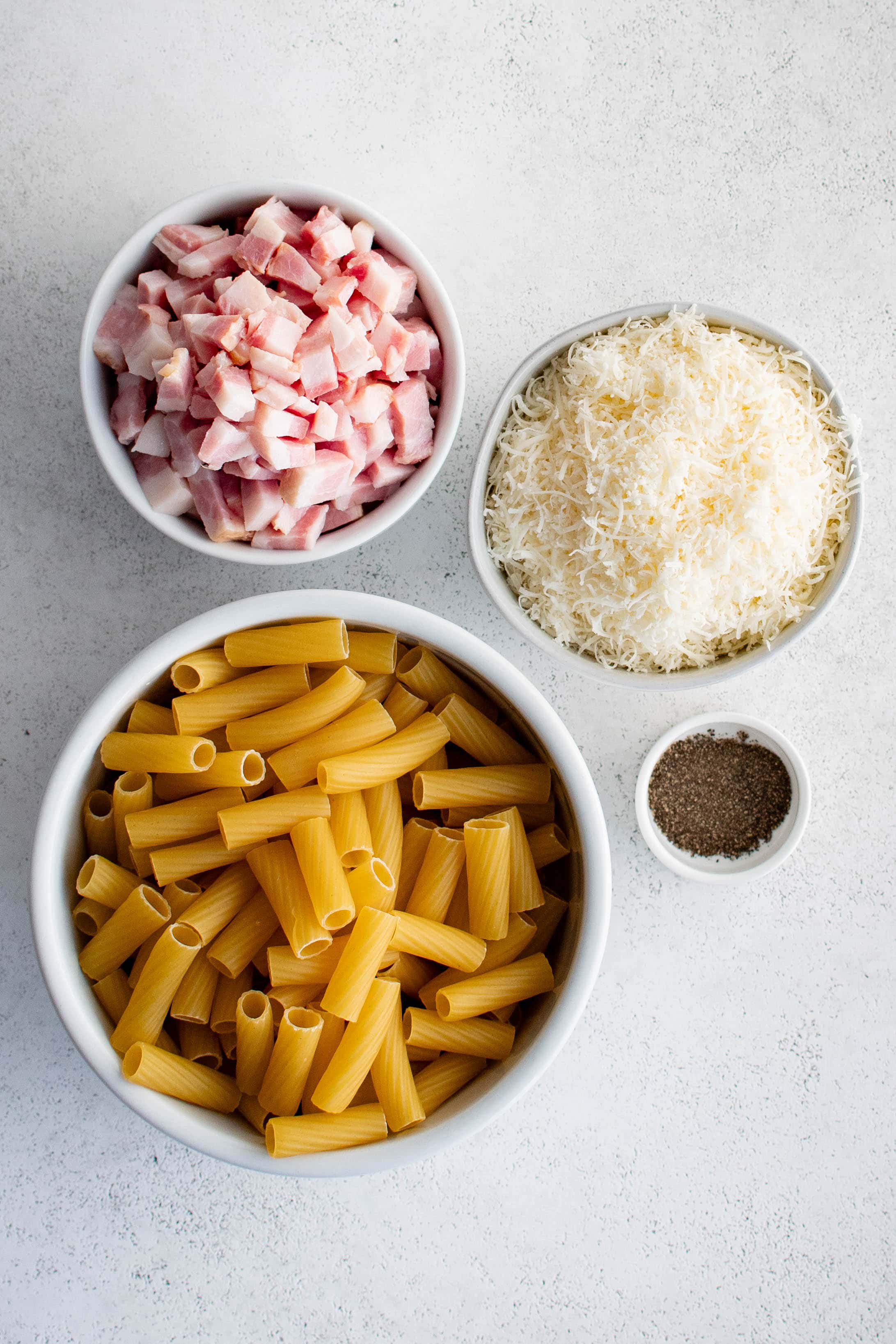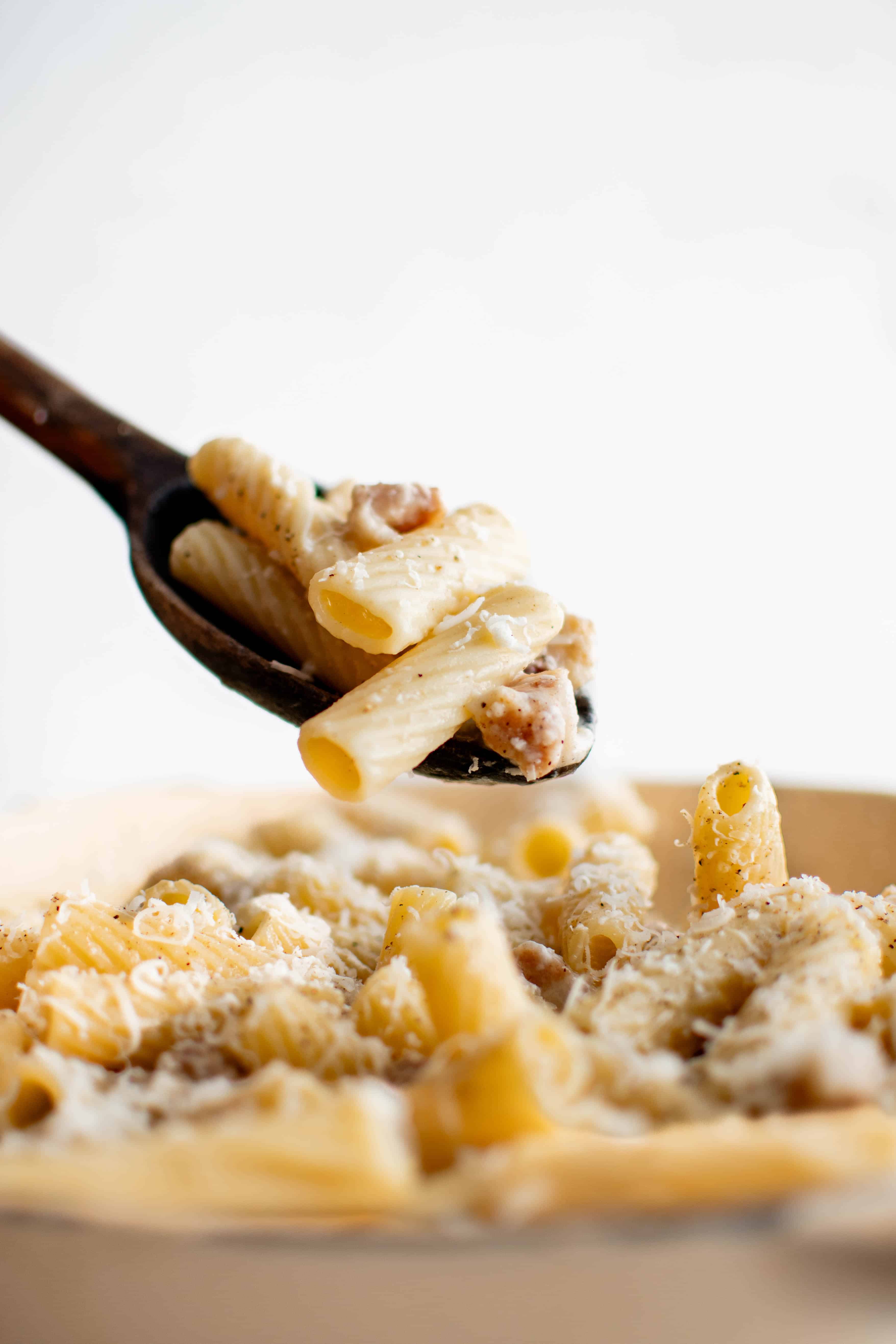This post may contain affiliate links. Please read our disclosure policy.
Pasta Alla Gricia is an ancient Roman pasta dish made with just four simple and flavorful ingredients – pasta, guanciale (or prosciutto), Pecorino Romano cheese, and black pepper. It’s an easy 20-minute pasta dinner that’s always delicious and so flavorful.

If you love cacio e pepe, then you are going to love pasta alla gricia. Identical in all ways, the only difference is that pasta alla gricia contains guanciale – a type of cured pork.
Absolutely delicious and so easy to make!
What is Pasta Alla Gricia
Pasta alla gricia is an ancient Roman pasta dish dating back to around 400 AD. The beauty of this dish lies in its use of simple, high-quality ingredients. With just four main ingredients – pasta, guanciale (cured pork), Pecorino Romano cheese, and black pepper – it’s the perfect example of how just a few ingredients can come together to create a perfectly flavorful, delicious pasta recipe.
Sometimes referred to as “Amatriciana Bianca,” Pasta alla gricia is considered a precursor to other popular pasta dishes like Pasta all’Amatriciana but without tomatoes or Pasta Carbonara but without the eggs.
When made right, it’s a harmonious blend of the saltiness from the guanciale and Pecorino Romano, combined with the kick of black pepper, all beautifully coating the pasta.

Pasta Alla Gricia Ingredients
- Guanciale: Guanciale is a traditional Italian cured meat made from pork jowl or pork cheek. It’s made by rubbing the pork with salt, sugar, and spices like black pepper and thyme or fennel and sometimes garlic. After being rubbed with these seasonings, the meat is left to cure for several weeks. The curing process allows guanciale to develop a deep, rich flavor that distinguishes it from other cured meats. It is prized for its unique taste and fatty richness. A popular ingredient in Italy, it can be harder to find here in the US. If unavailable, pancetta (cured pork belly) can be used as a substitute.
- Pasta: The most traditional pasta shape is rigatoni, spaghetti, or bucatini. Rigatoni, with its tubular shape, is especially popular as it’s good at holding onto the bits of guanciale and creamy sauce formed from the Pecorino Romano cheese combined with rendered fat from the guanciale and pasta cooking water.
- Pecorino Romano Cheese: A sharp, salty, aged sheep’s milk cheese that’s essential to this dish. For best results, finely grate the cheese by hand. Parmigiano-Reggiano cheese can be used as a substitute.
- Black Pepper: Freshly ground black pepper adds warmth and spice. For the best flavor, use freshly ground black pepper.
- Salt: Salt will be needed to season the pasta water and adjust the flavor of the dish. Take care not to add salt before tasting as the guanciale is already quite salty.


How to Make Pasta alla Gricia
1. Cook the guanciale: Add the guanciale to a cold skillet and heat over medium heat. Cook it until it becomes crispy and golden brown and the fat is rendered, about 5-7 minutes.
2. Boil the pasta: Bring a large pot of salted water to a boil and cook the pasta for 2 minutes less than the time indicated on the box. Once cooked, reserve at least 2-3 cups of the pasta cooking water, then drain in a large colander and set aside.
3. Prepare the sauce: Add one cup of reserved cooking water to the pan with the rendered fat and crispy guanciale. Stir in the freshly cracked black pepper and bring to a gentle simmer before adding the pasta.



4. Add the pasta: Gently toss the pasta in the sauce. Cook for 1-2 minutes or until the sauce starts to thicken and the pasta is cooked through.
5. Stir in the Pecorino Romano cheese: Remove the pan from heat. Slowly stir the grated cheese until is is completely smooth and melted. Add additional pasta cooking water, if needed, and season with additional salt and black pepper, to taste.
6. Garnish and Serve: Garnish with additional Pecorino Romano cheese and freshly ground black pepper if desired.

Recipe Tips
- Grate the cheese by hand: There are several benefits to finely grating cheese by hand. Most importantly, cheese grated by hand retains more of its original, wonderful, and delicious flavor. Freshly grated cheese also melts more quickly and evenly. This is especially beneficial when making pasta dishes where cheese needs to melt into a sauce.
- Reserve extra pasta cooking water: When making recipes that call for pasta cooking water, always reserve more than the recipe estimates you’ll need. You may not use all of it, and that’s okay, but sometimes you’ll wish you had more. And the salty, starchy, reserved cooking water can’t be replicated (unless you boil more pasta).
- Wait to add additional salt: You will find that this dish is already quite salty from the guanciale and salted pasta water. Avoid accidentally over-salting the dish and hold off on adding additional salt until you’ve tasted the sauce.

Storage and Reheating
Allow leftovers to cool to room temperature before transferring them to an airtight container or ziplock bag. Keep stored in the refrigerator for up to 2-3 days. Reheat in the microwave at 30-second intervals, stirring between each interval, until heated through. Or, reheat in a warm skillet on the stovetop with a splash of water or olive oil until the pasta is reheated. Add a bit more grated Pecorino Romano, if desired. Freezing Pasta alla Gricia is not recommended.

More Pasta Recipes
- Creamy Cajun Shrimp Pasta
- Pasta with Bacon and Peas
- Creamy Lemon Chicken Pasta
- 30 Minute Creamy Ham and Pea Pasta
- Ground Turkey Pasta Recipe
- Easy Bacon Broccoli Pasta Recipe
If you try making this Rigatoni alla Gricia Recipe, please leave me a comment and let me know! I always love to hear your thoughts.


Pasta Alla Gricia Recipe
Ingredients
- 6 ounces Guanciale, or pancetta, diced
- 12 ounces rigatoni pasta, or spaghetti
- ¼ teaspoon Ground black pepper
- 4 ounces Pecorino Romano cheese, freshly grated
Instructions
- Add the guanciale to a cold skillet and heat over medium heat. Cook it until it becomes crispy and golden brown, about 5-7 minutes.
- Bring a large pot of salted water to a boil and cook the pasta for 2 minutes less than the time indicated on the box. Once cooked, reserve at least 2 cups of the pasta cooking water. Drain the pasta and set aside.
- Add 1 cup of reserved pasta water to the same skillet as the cooked guanciale. Bring to a simmer and add the freshly cracked black pepper. Once it reaches a simmer, gently toss in the cooked pasta, adding additional pasta water as needed.
- Cook the pasta for 1-2 minutes or until the sauce starts to thicken and the pasta is cooked through.
- Remove the pan from the heat. Allow it to cool for 1-2 minutes before gradually tossing in the cheese. Once all the cheese is added and melted, season with additional salt and black pepper to taste.
- Garnish with extra Pecorino Romano cheese and freshly ground black pepper if desired.
Notes
Nutrition
Nutrition information is automatically calculated, so should only be used as an approximation.














